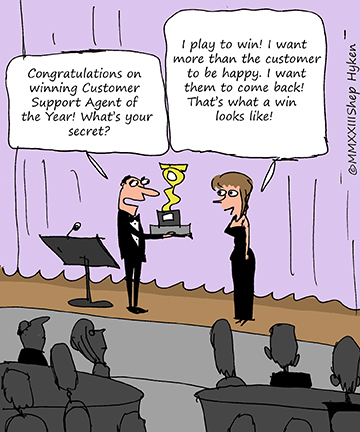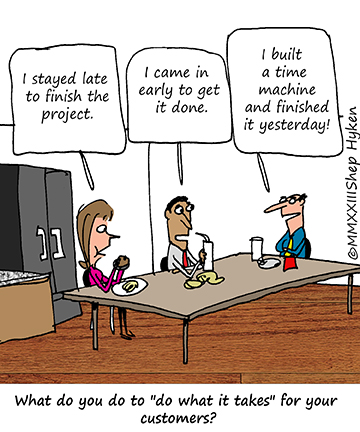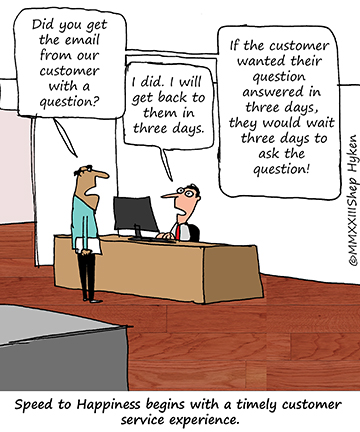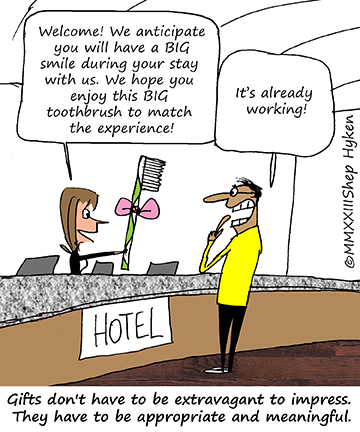
GUEST POST from Shep Hyken
What’s happening on the inside of an organization is felt on the outside by the customer. It is more important than ever to create a culture that attracts and retains the best employees. Good or bad, the culture and employees operating within it will influence the customer experience. That’s why today we’re going to dive into creating a workplace culture that gets and keeps your best people.
“Toxic workplace” is a common buzzword in today’s society. An article in Business Insider says nearly 30 million U.S. workers think their workplace is toxic. However, toxic workplaces don’t usually start out that way, and if they do, they find it difficult to survive in today’s hyper-competitive landscape. So, assuming the path is paved with good intentions, what goes wrong along the way?
While many companies are founded upon core values, rarely are those values consistently seen throughout the organization’s leadership. The two keywords in this statement are consistent and leadership. If your organization’s leadership and management aren’t representing its stated values, how can you expect their supporting employees to do so? Moreover, if the leadership isn’t consistently representing the company values, their actions can be even more polarizing.
Like it or not, humans remember bad memories longer than good memories; it’s a scientific fact that leads back to evolutionary behaviors. That means if your leaders are not consistently, meaning always, acting with the organization’s core values in mind, they aren’t representing the values at all. This will be noticed and remembered by employees. And, you can’t expect your people to act any differently than the leaders they are supposed to follow and admire.
So why implement a corporate culture in the first place? Jonathan Keyser, the Wall Street Journal bestselling author of You Don’t Have to Be Ruthless to Win, states, “A good culture equates to so much more than just an enjoyable workplace or a happy team. A strong culture acts as a safeguard to protect your business’s most valuable resources. When companies do not focus on their culture, they are prone to significant setbacks, including a loss of brain trust, costly recruiting fees, training and development time, and stunted interpersonal collaboration, which all equate to a financial loss.”
When Keyser is not out speaking to organizations about how to create the culture of selfless service that gets employees to stay, he’s running a successful commercial real estate company. USA Today calls Keyser “The Commercial Real Estate Industry Disrupter.” I had a chance to meet with Keyser to discuss his book and he shared five steps to creating a healthy workplace culture:
1. Reflect – Keyser asks, “What type of employee do you want to attract?” You start by creating a mental persona for that individual. You want to define the behaviors and attitudes you are seeking. You also want to know what would attract that person to your organization. That will be reflected in your organization’s behavior. Keyser adds, “Once you define what’s important to your employees, follow the same process for your clients.”
2. Specify – Keyser says, “The problem with most corporate values is they are ambiguous. Companies will write words and phrases like integrity, teamwork and hard work on their office walls and don’t give context as to what those words truly mean within the workplace.” Go beyond the writing of the words and add simple and clear definitions or descriptions of how they are to be used at work. Start with your core value key phrases—what do they mean in relation to how your team interacts with each other and the outside world?
3. Differentiate – Is the culture you are implementing different enough from your competitors to win the attention of recruits? If not, you’re just like any other employer. You want to find your difference. For example, one of Keyser’s core principles is to be bold. Plenty of companies claim to be bold. However, Keyser takes it one step further and clearly defines what this means in his company. He says that they do not punish mistakes, because fear of mistakes keeps a person from being bold and willing to take massive action, which is where value is created.
4. Implement – This goes back to the second step, specify. One toxic person can destroy a culture, so it’s crucial to be specific when you outline what type of behavior is expected of your team and what corrective action should be taken if you find misalignment. The words you “write on your walls” must come to life.
5. Realign – The question isn’t if you’ll go out of alignment with the culture you’ve created (or want to create), it’s when. Keyser suggests constantly monitoring and evaluating the culture. Speak to members at the top and bottom of your organization, have your HR team conduct exit interviews, and check online sources like Glassdoor regularly. Keyser says, “A toxic workplace can spread like wildfire, so it’s your job to investigate proactively and realign when necessary.” I refer to this as defending the culture, which may be one of the most important jobs of a leader.
A toxic workplace will challenge the company to keep not only employees, but also customers. The leaders’ ability to define core values, as well as live and demonstrate them to employees is the key to creating an enduring, positive culture. These five steps to creating a healthy workplace culture will also help you prevent a toxic culture so you retain your best employees—and your best customers.
This article originally appeared on Forbes.com
Image Credits: Shep Hyken
 Sign up here to join 17,000+ leaders getting Human-Centered Change & Innovation Weekly delivered to their inbox every week.
Sign up here to join 17,000+ leaders getting Human-Centered Change & Innovation Weekly delivered to their inbox every week.


![]() Sign up here to join 17,000+ leaders getting Human-Centered Change & Innovation Weekly delivered to their inbox every week.
Sign up here to join 17,000+ leaders getting Human-Centered Change & Innovation Weekly delivered to their inbox every week.











